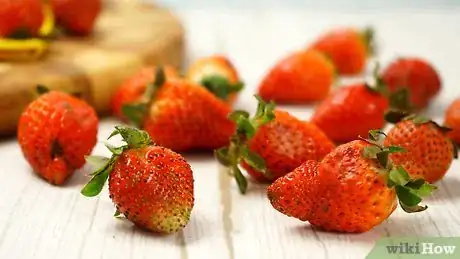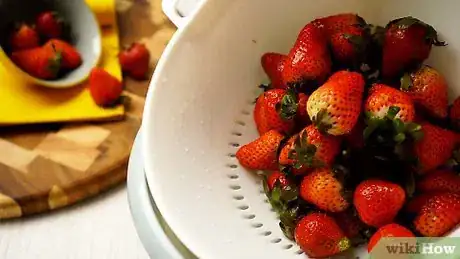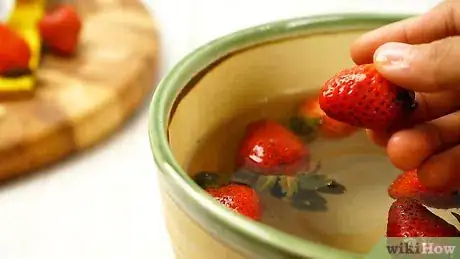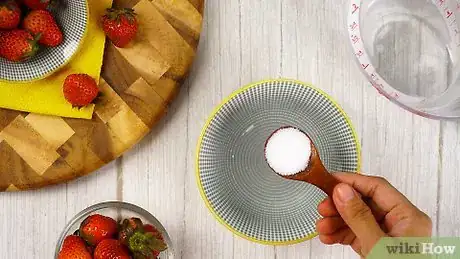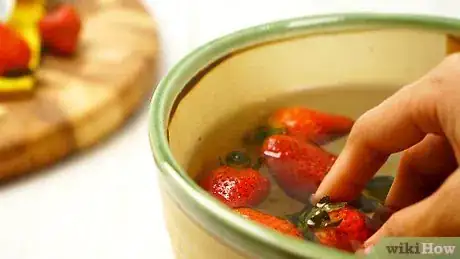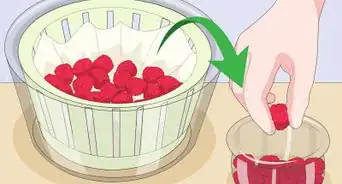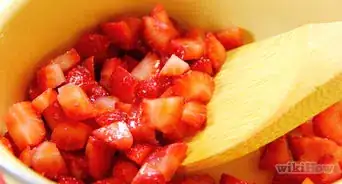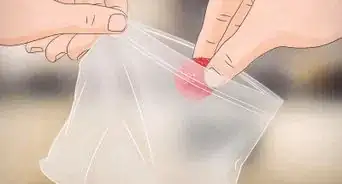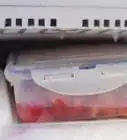This article was co-authored by wikiHow Staff. Our trained team of editors and researchers validate articles for accuracy and comprehensiveness. wikiHow's Content Management Team carefully monitors the work from our editorial staff to ensure that each article is backed by trusted research and meets our high quality standards.
There are 7 references cited in this article, which can be found at the bottom of the page.
The wikiHow Culinary Team also followed the article's instructions and verified that they work.
This article has been viewed 245,647 times.
Learn more...
Strawberries are a delicious and good source of vitamin c, folic acid, antioxidants and fiber. They are not only part of a healthy diet but can help reduce the risk of heart disease as well.[1] [2] However, like any other fresh produce, strawberries need to be cleaned carefully before consumption as they can become contaminated with harmful bacteria such as salmonella or E. coli. Plus, strawberries are one of the “dirty dozen,” foods that contain the most pesticides.[3]
Steps
Washing Strawberries in Water
-
1Remove bad or spoiled strawberries. Don’t wash them before you’re ready to use them, though, as strawberries act like sponges. They absorb water fast, which speeds up spoiling.
- Discard strawberries that are bruised, mushy, moldy or not ripe. Keep strawberries that have a deep red color and are plump.
- Don’t remove the stem before washing as that way the strawberries will just absorb water.
-
2Place strawberries in a large clean colander. It’s important not to ever soak them in water.
- Wash the strawberries under clean running water.
- Keep moving them gently with hands making sure each one gets washed.
Advertisement -
3Clean them in a basin of cool water alternatively.[4]
- Hold a few strawberries in hand and slosh them through the water.
- Rather than being submerged, strawberries need to be given a quick rinse.
-
4Dry the strawberries. When left wet, berries start going bad fast. Even if they are left wet to air dry, they will absorb the water and taste less sweet.
- Let them drain in the colander for a minute.
- Pat them dry with a paper towel. Be careful not to damage the fruit.
- Alternatively, spread them on a clean kitchen towel and gently rub them dry.
Cleaning Strawberries with Vinegar Solution
-
1Clean the strawberries more thoroughly with a vinegar solution. This also helps keep them from getting spoiled too fast in the refrigerator. It’s frustrating to buy a carton of strawberries and to find them covered in white fuzz two days later.[5]
- You should discard strawberries that are moldy or squished.
- Again, keep the stem on until you are ready to use the berries in your recipe or to eat.
-
2Prepare the vinegar solution. You will need white vinegar and a basin or sink.
- Fill up half a clean basin or sink with cold water. Make sure the water is not warm.
- Add 1 cup vinegar for every 3 cups of water.[6]
- Mix the solution well with your hand.
-
3Grab two or three strawberries. You will clean a few strawberries at the time. This ensures you are cleaning each one properly.
- Run strawberries vigorously for about 30 seconds through the vinegar solution.
- Rinse those strawberries well under cold water. You don’t want any of the vinegar flavor to remain on the fruit.
- Pat the fruit dry with paper towels, or dry it gently with a kitchen towel.
Using Veggie Wash
-
1Prepare the Veggie Wash solution. You can purchase Veggie Wash at most major food supermarkets.
- Fill up half a clean basin or a sink with cold water.
- Add 2 oz of Veggie Wash and stir.
- Give the solution a good swirl.
-
2Grab up to two or three strawberries in your hand. This ensures each piece gets cleaned properly.
- Run strawberries vigorously for about 30 seconds through the Veggie Wash solution.
- Rinse those strawberries well under cold running water. You don’t want any of the Veggie Wash residue to remain on the fruit.
- Pat the fruit dry with paper towels, or gently dry it with a kitchen towel.
Community Q&A
-
QuestionDo people usually cut the centers out of their strawberries?
 Community AnswerSome people do, but it's not necessary. Whether you do or not is up to you.
Community AnswerSome people do, but it's not necessary. Whether you do or not is up to you. -
QuestionWill the vinegar wash remove harmful bacteria?
 Community AnswerNot by itself. But if you leave the vinegar on for a minute and then spray with peroxide and rinse, it will kill the bacteria.
Community AnswerNot by itself. But if you leave the vinegar on for a minute and then spray with peroxide and rinse, it will kill the bacteria. -
QuestionShould I clean commercially frozen, bagged strawberries?
 Community AnswerYou could rinse them if you wanted to, but it's not necessary.
Community AnswerYou could rinse them if you wanted to, but it's not necessary.
References
- ↑ http://www.foodrepublic.com/2013/05/20/14-things-you-didnt-know-about-strawberries
- ↑ http://www.nutrition-and-you.com/strawberries.html
- ↑ http://www.ewg.org/foodnews/summary.php
- ↑ https://www.youtube.com/watch?v=A7O2BNOOY5E
- ↑ https://www.thekitchn.com/smart-tip-keep-berries-fresh-longer-with-this-washing-method-172141
- ↑ http://food52.com/blog/6970-how-to-keep-berries-fresh-for-longer
- ↑ https://www.youtube.com/watch?v=dNrfrcvnGA4
About This Article
To clean strawberries, first fill a large bowl with 4 parts water and 1 part white vinegar. Place the strawberries in the vinegar solution and let them soak for 20 minutes. Then, drain the strawberries into a colander and rinse them thoroughly with cool water. Rotate the strawberries in the colander while rinsing them so the water gets to all of the fruit. Finally, pat the strawberries dry with paper towels. For organic strawberries, you can just rinse them off with cool water in a colander to clean them since they shouldn't have any pesticides on them. If you want to learn how to use a vinegar solution for cleaning your berries, keep reading!
